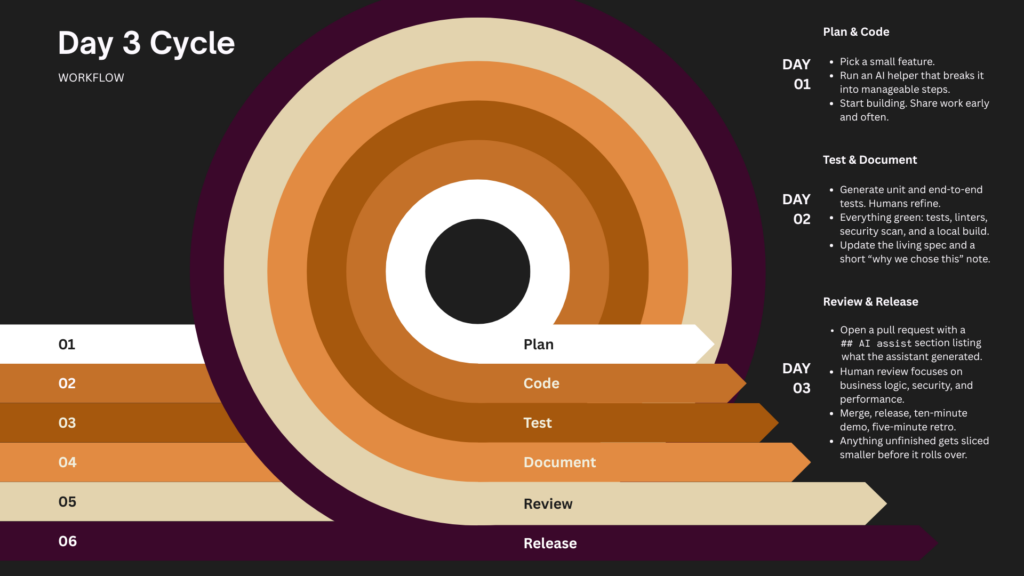100px
You’ve probably seen the flashy AI demos:
“Just use this week’s AI darling,” a solo founder touts as a “bruh” solution while a new app magically appears in seconds.
Yes, AI is here, and it’s awesome. We’re leveraging it, but AI isn’t a replacement for humans. It’s a tool we can use, but we’re not throwing the baby out with the bath water.
We’re testing a practical, repeatable way to use AI to speed up software delivery without getting rid of everything that already works or sacrificing security.
We call it the Day 3 Cycle.
It combines:
```feature: Checkout totals
context: Logged-in user with items in cart
rules:
- promotions applied before tax
- shipping calculated by region
api:
POST /api/checkout/calc:
request: { cartId: string }
response: { subtotal: number, discounts: number, tax: number, shipping: number, total: number }
tests:
- “applies 10% promo then tax”
- “free shipping over 75”
non_functional:
- response time p95 < 150msThe editor reads this, scaffolds handlers, tests, and documentation. If you change code by hand, update the spec so intent and implementation never drift.
Agile was supposed to help us “respond to change.” But 20 years into using the Agile Sprint Model, we’re stuck in endless planning meetings and never-ending task tickets.
So, when you add an AI assistant into that mess, things can go sideways even faster:
Think about what people already accomplish in merely three days:
Three days is enough to do something real with focus, feedback, and finishing.
If you can take a trip in 3 days, you can ship in 3 days.
That’s the same mindset behind the Day 3 Cycle: A complete software loop (Plan, Build, Test, Ship) in three days.
It’s a faster, tighter way to build software

If you have unfinished work, break it down smaller or send it back to the backlog.
This is a lost or forgotten art, swept aside in the Agile race to constantly look busy. But in the age of AI, it’s essential.
stack-guidelines (always on): language versions, formatting, test thresholds, commit style.process-task (run when you pick a ticket): decomposes the work into tiny steps, then guides build → test → doc → commit.Definition of Done (for each ticket):
The Day 3 Cycle isn’t some mythical shortcut. It’s a tool that works because it’s grounded in how real teams actually build. And it isn’t super rigid. It’ll evolve as AI tools evolve.
Right now, it’s a repeatable system that helps teams move faster without sacrificing quality or burning out.
Try one Day 3 Cycle on a low-risk feature. You may discover the future of professional software development hiding inside a schedule shorter than your old sprint-planning meeting. It’s a smart system that fits inside your normal week…only a little faster, a little clearer, and a whole lot less painful.
If your process feels slow, or you’re not sure how to use AI without breaking things, let’s talk. I can work with your team to test the Day 3 Cycle and get you shipping faster, without the fragility. Simply schedule a free deep dive here so you can walk away with clarity from our call with a plan to follow and my top 3 recommendations for you.
Happy prompting. And may your next stand-up meeting finally be shorter than your coffee break.